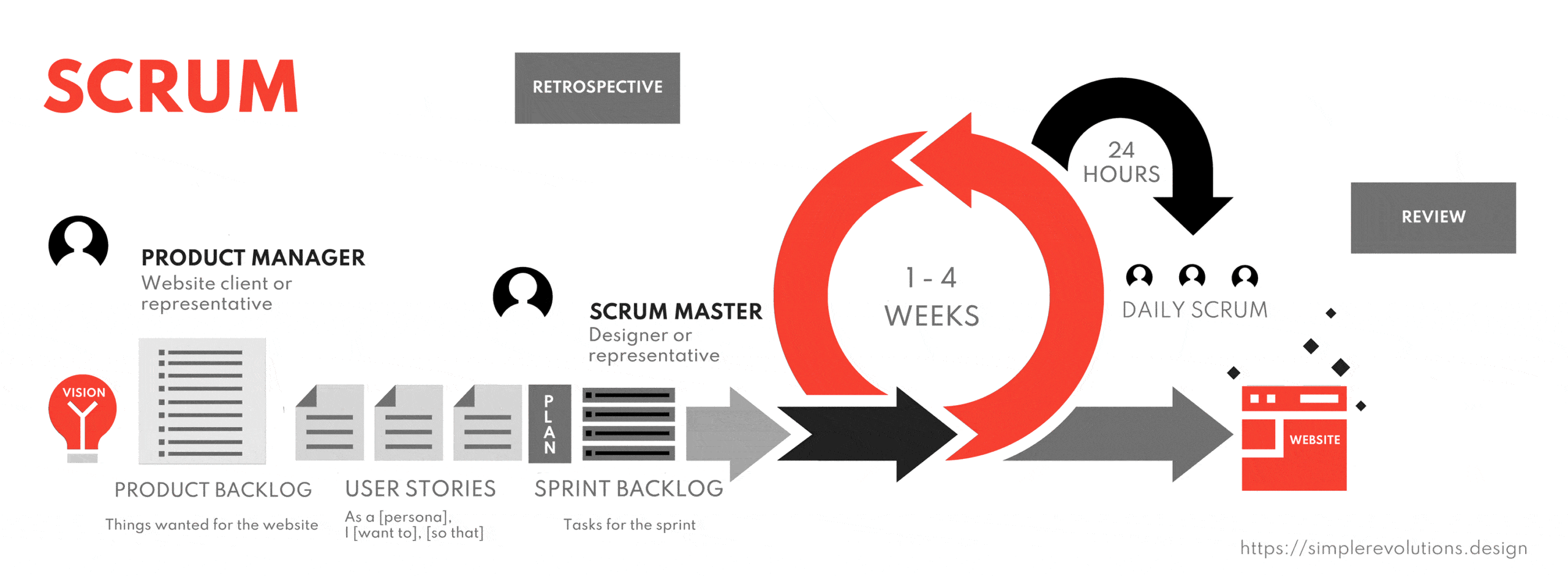Using Scrum to make our businesses Agile
In the last video I talked about agile and how it is a mindset and a reaction to the problems of traditional project management.
Here, we are looking at Scrum, which is a lightweight framework for implementing agile. It was created by two of the authors of the Agile manifesto (Jeff Sutherland and Ken Schwaber)
Context first
This blog is for freelancers and small agencies who do it all and so probably implement a solution like WordPress. For us, Scrum is probably the one to look at first.
If your agency has a team of code specialists and your clients are likely to want you to build the next Facebook you might already be looking at other agile frameworks like Extreme Programming (XP) or Kanban.
I don’t have any reliable statistics, but Scrum is generally considered the most widely used agile framework (most seem to quote over 65%). It’s designed for teams, but I feel it will work fine for freelancers too.
I won’t be applying everything that’s recommended by scrum.org. This blog is about finding our own custom ways to become agile.
Some years ago, one of the contributors to the manifesto (Dave Thomas) declared Agile dead (like PHP. SEO and WordPress Page Builders)
He still firmly believes in it, but felt businesses were buying the agile frameworks, but were applying them with a traditional mindset.
Many of us will have experienced something similar with clients and digital marketing. When the internet flipped everything on its head by putting the audience in control of what they consumed, we needed to move from “push” to “pull” marketing.
Blogs and social media were great platforms to “pull” in people with engaging and helpful content, but many businesses adopted the platforms, but continued with a traditional advertising (or push marketing) mindset.
“We tried it and it did not work for us” is something we are likely to hear about agile and we have with content marketing.
Finally, I should say I have never ( knowingly) been in a Scrum team. My former employer, a government department, adopted agile, but I didn’t experience it.
The closest I have got is with the trial and error tweaks I made to my business.
The Scrum Workflow
Click the image to make it full-width
There is an official diagram over at scrum.org, but I’ve created my own to add in some additional components and make it more relevant to web designers. If you go to my blog post and click on the image, it will pop-up full-width.
My explanation will be simplified to keep this an overview.
I hope from the diagram you see the process starts on the left with the client’s vision.
This is turned into a prioritised list of tasks called the Product Backlog. We could call it the Website Wishlist.
The items are then turned into User Stories as a way of making clear what needs to happen. Keeping it simple, we can turn them into statements like this:
“As a [persona/type of website visitor] I [want to], [so that]”
I will return to this later as there is an alternative approach called Lean UX which tests for business viability.
The Sprint backlog is the tasks selected for the first or next sprint of work.
A Scrum team is ideally under 10 people with a range of needed skills. The idea is that they are self organising and will collaborate with each other rather than rigidly stick to their own disciplines. Scrum name is borrowed from Rugby and gives us a visual representation of how the working spirit should be.
I would often be a team of 2. Me and the client. A 3rd person could be my wife and occasionally the client or I might need to bring in additional expertise for a sprint.
Scrum.org recommends 1 – 4 weeks for a sprint with Daily Scrum. A stand up meeting (maybe 15 minutes) to say where each member is up to and are doing next.
They are just recommendations. There’s no point in ritual meetings if the communication and focus is already good. No point in stretching out a sprint that could be done in a couple of days.
There are two key roles in a Scrum team. The Product Manager who could be the client or someone representing them and the Scrum Master, which is likely to be us.
- The Product Manager reports to the wider organisation and should be able to offer valuable input about the business aims characteristics and how their customers are likely to behave.
- The Scrum Master does everything to keep the scrum running smoothly so the sprint backlog is executed.
Ovidiu from WP code box (aff. link) and our Facebook group has experience with agile and was telling me he’s seen difficulties with client representatives appointing themselves as Scrum Master. It’s a cooler name and you can get a Scrum Master certificate in one day!
Certainly, I can see with some organisation’s long-standing culture how the agile idea of self-determining teams can unwittingly get turned into a more traditional micro management set up.
There is an outer flow in the diagram (shown in the darker grey boxes) is the Scrum planning, review and retrospective.
The Scrum Review tests the result of the sprint backlog to see how it is working.
The Scrum Retrospective looks at what has been learned by the team and will help in planning for the next Sprint backlog. It could affect the Product Backlog and is likely to include higher management.
But let’s Keep it Simple
It’s easy to get needlessly lost in the definitions of the new terminology and roles.
Selling Agile consultancy, training and tools is a booming business. Large companies, with deep pockets, are keen ( to follow the multi-billionaire tech companies) and “go agile”
The more complex a solution sounds, the more value it has.
We can strip the agile workflow down to what we need it to be. Sometimes more like a traditional approach.
For example, if the client places complete trust in you to deliver the design (or part of it) and has the content ready. You could exclude them from the sprint. The sprint backlog then becomes your personal “to do list”.
For me, the power of having an agile process available is you are ready when you and a client are unsure how a project should go.
Instead of entering into a BS negotiation over the cost of the unknown or trying to fix what needs to be fluid, you just get started!
For example, you might suggest that the first sprint on a new site is a fixed cost landing page to:
- Offer a low risk way to see how you work together.
- Get something out that can start earning.
- Get a head start with SEO/marketing efforts.
- Get some early user data.
If you normally work alone with a single client, you have a way to incorporate other specialists when needed.
Scrum does not need complex and expensive project management tools. If you work completely online Google docs and Skype (or similar) may be all you need.
I will dig deeper into tools later, but for my follow up post I’d like to explain why I think being able to offer an agile approach could help us attract more clients and allow us to stand out in a crowded industry.
Without wanting to go all “Da Vinci Code” on you, I think the Agile manifesto offers us some clues to how we might improve our own marketing messages.
Even if not, many companies are clamouring to “go agile” so having this approach under our belts could make us a more attractive proposition.


